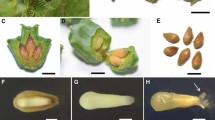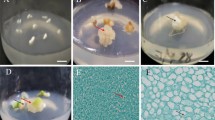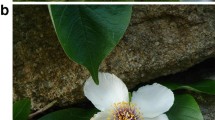Abstract
Wild populations of Paphiopedilum niveum (Rchb.f.) Stein, an endangered orchid species, have been threatened with extinction due to climate change and overcollection. Conventional methods of propagation are unable to meet market demands. The current study reports the production of genetically stable, protocorm-derived protocorm-like bodies (PLBs) of P. niveum that can be used for commercial production. These PLBs are referred to hereafter as somatic embryos (SEs). Factors affecting SE induction and SE proliferation were examined. The highest percentage of SE formation (68.33 ± 11.77%) and the maximum number of SEs per explant (5.19 ± 0.67) were obtained on modified Vacin and Went (MVW) medium containing 0.1 mg L−1 1-naphthaleneacetic acid (NAA). The highest increase in fresh weight (FW) of proliferated SEs (183.33 ± 28.93 mg per 100 mg initial FW) was gained on hormone-free MVW. These SEs eventually developed into vigorous plantlets after culturing on MVW supplemented with 0.2% (w/v) activated charcoal and 50 g L−1 banana homogenate for 12 wk. A histological study revealed that SEs originated from both the epidermal and the sub-epidermal layers of the original protocorm via direct somatic embryogenesis. The genetic homogeneity between the mother generation (V1; the original protocorm) and subsequent generations (V2 and V3; the primary and secondary somatic embryos, respectively) was shown to be identical via random amplification of polymorphic DNA (RAPD) assessment. All regenerated plants grew well under greenhouse conditions.




Similar content being viewed by others
References
Agarwal T, Gupta AK, Patal AK, Shekhawat NS (2015) Micropropagation and validation of genetic homogeneity of Alhagi maurorum using SCoT, ISSR and RAPD markers. Plant Cell Tissue Organ Cult 120:313–323. https://doi.org/10.1007/s11240-014-0608-z
Ahamed Sherif N, Franklin Benjamin NH, Senthil Kumar T, Rao MV (2018) Somatic embryogenesis, acclimatization and genetic homogeneity assessment of regenerated plantlets of Anoectochilus elatus Lindl., an endangered terrestrial jewel orchid. Plant Cell Tissue Organ Cult 132:303–316. https://doi.org/10.1007/s11240-017-1330-4
Bairu MW, Aremu AO, Van Staden J (2011) Somaclonal variation in plants: causes and detection methods. Plant Growth Regul 63:147–173. https://doi.org/10.1007/s10725-010-9554-x
Bhattacharyya P, Kumaria S, Diengdoh R, Tandon P (2014) Genetic stability and phytochemical analysis of the in vitro regenerated plants of Dendrobium nobile Lindl., an endangered medicinal orchid. Meta Gene 2:489–504. https://doi.org/10.1016/j.mgene.2014.06.003
Chen JT, Chang WC (2001) Effects of auxins and cytokinins on direct somatic embryogenesis on leaf explants of Oncidium ‘Gower Ramsey’. Plant Growth Regul 34:229–232. https://doi.org/10.1023/A:1013304101647
Chen LR, Chen JT, Chang WC (2002) Efficient production of protocorm-like bodies and plant regeneration from flower stalk explants of the sympodial orchid Epidendrum radicans. In Vitro Cell Dev Biol Plant 38:441–445. https://doi.org/10.1079/IVP2002315
Chen WH, Chen TM, Fu YM, Hsieh RM, Chen WS (1998) Studies on somaclonal variation in Phalaenopsis. Plant Cell Rep 18:7–13. https://doi.org/10.1007/s002990050523
Chuang SJ, Chen CL, Chen JJ, Chou WY, Sung JM (2009) Detection of somaclonal variation in micro-propagated Echinacea purpurea using AFLP marker. Sci Hortic 120:121–126. https://doi.org/10.1016/j.scienta.2008.09.020
Chung SY, Choi SH, Kim MJ, Yoon KE, Lee GP, Lee JS, Ryu KH (2006) Genetic relationship and differentiation of Pahphiopedilum and Phragmepedium based on RAPD analysis. Sci Hortic 190:153–159. https://doi.org/10.1016/j.scienta,2006.04.005
Desjardins P, Conklin D (2010) NanoDrop microvolume quantitation of nucleic acids. J Vis Exp 45:e2565. https://doi.org/10.3791/2565
Ferreira WDM, Kerbauy GB, Costa APP (2006) Micropropagation and genetic stability of a Dendrobium hybrid (Orchidaceae). In Vitro Cell Dev Biol Plant 42:568–571
Gamborg OL, Miller RA, Ojima K (1968) Nutrient requirements of suspension cultures of soybean root cells. Exp Cell Res 50:151–115
Gow WP, Chen JT, Chang WC (2010) Enhancement of direct somatic embryogenesis and plantlet growth from leaf explant of Phalaenopsis by adjusting culture period and explant length. Acta Physiol Plant 32:621–627. https://doi.org/10.1007/s11738-009-0438-5
Guo B, Abbasi BH, Zeb A, Xu LL, Wei YH (2011) Thidiazuron: a multi-dimensional plant growth regulator. Afr J Biotechnol 10:8984–9000. https://doi.org/10.5897/AJB11.636
Gupta S, Pandotra P, Gupta AP, Verma MK, Ahuja A, Vishwakarma RA (2013) Direct rhizogenesis, in vitro stolon proliferation and high-throughput regeneration of plantlets in Glycyrrhiza glabra. Acta Physiol Plant 35:2669–2705. https://doi.org/10.1007/s11738-013-1302-1
Hong PI, Chen JT, Chang WC (2008) Plant regeneration via protocorm-like body formation and shoot multiplication from seed-derived callus of a maudiae type slipper orchid. Acta Physiol Plant 30:755–759. https://doi.org/10.1007/s11738-008-0158-2
Ji A, Geng X, Zhang Y, Yang H, Wu G (2011) Advance in somatic embryogenesis research of horticultural plants. Am J Plant Sci 2:727–732. https://doi.org/10.4236/ajps.2011.26087
Johansen DA (1940) Plant microtechinque, 1st edn. McGraw-Hill Book Co Inc, New York
Kaewubon P, Sangdam S, Thammasiri K, Meesawat U (2010) Plant regeneration through somatic embryogenesis from callus-derived PLBs of tropical slipper orchid (Paphiopedilum niveum (Rchb.f.) Pfitz.). Floricul Ornam Biotechnol 4(Special Issue 1):29–35
Krishna H, Alizadeh M, Singh D, Singh U, Chauhan N, Eftekhari M, Sadh RK (2016) Somaclonal variations and their applications in horticultural crops improvement. 3 Biotech 6:54. https://doi.org/10.1007/s13205-016-0389-7
Lee YI (2007) The asymbiotic seed germination of six Paphiopedilum species in relation to the time of seed collection and seed pretreatment. Acta Hortic 755:381–381. https://doi.org/10.17660/ActaHortic.2007.755.50
Lee YI, Hsu ST, Yeung EC (2013) Orchid protocorm-like bodies are somatic embryos. Am J Bot 100:2121–2131. https://doi.org/10.3732/ajb.1300193
Liu F, Huang LL, Li YL, Reinhoud P, Jongsma MA, Wang CY (2011) Shoot organogenesis in leaf explant of Hydrangea macrophylla ‘Hyd1’ and assessing genetic stability of regenerants using ISSR markers. Plant Cell Tissue Organ Cult 104:111–117. https://doi.org/10.1007/s11240-010-9797-2
Machakova I, Zazimalova E, George EF (2008) Plant growth regulators I: introduction; auxins, their analogues and inhibitors. In: George EF, Hall MA, De Klerk GJ (eds) Plant propagation by tissue culture, 3rd edn. Springer, Dordrecht, pp 175–204
Mahendran G, Bai NV (2012) Direct somatic embryogenesis and plant regeneration from seed derived protocorms of Cymbidium bicolor Lindl. Sci Hortic 135:40–44. https://doi.org/10.1016/j.scienta.2011.12.003
Malabadi RB, Mulgund GS, Nataraja K (2004) Efficient regeneration of Vanda coerulea, an endangered orchid using thidiazuron. Plant Cell Tissue Organ Cult 76:289–293. https://doi.org/10.1023/B:TICU.0000009255.69476.b7
Martin M, Sarmenta D, Oliveira M (2004) Genetic stability of micropropagated almond plantlets, as assessed by RAPD and ISSR markers. Plant Cell Rep 23:492–496. https://doi.org/10.1007/s00299-004-0870-3
Mayer JLS, Stancato GC, Appezzato-Da-Glória (2010) Direct regeneration of protocorm-like bodies (PLBs) from leaf apices of Oncidium flesxuosum Sims (Orchidaceae). Plant Cell Tissue Organ Cult 103:411–416. https://doi.org/10.1007/s11240-010-9782-9
McGough HN, Roberts DL, Brodie C, Kowalczyk J (2006) CITES and slipper orchids: an introduction to slipper orchids covered by the convention on international trade in endangered species. Royal Botanic Gardens, Kew
Mitra GC, Prasad RN, Choudhury AR (1976) Inorganic salts and differentiation of protocorms in seed callus of an orchid and correlated changes in its free amino acid content. Indian J Exp Biol 14:350–351
Murashige T, Skoog F (1962) A revised medium for rapid growth and bioassays with tobacco tissue cultures. Physiol Plant 15:473–497. https://doi.org/10.1111/j.1399-3054.1962.tb08052.x
Ng CY, Saleh NM (2011) In vitro propagation of Paphiopedilum orchid through formation of protocorm-like bodies. Plant Cell Tissue Organ Cult 105:193–202. https://doi.org/10.1007/s11240-010-9851-0
Ng CY, Saleh NM, Zaman FQ (2010) In vitro multiplication of the rare and endangered slipper orchid, Paphiopedilum rothschildianum (Orchidaceae). Afr J Biotechnol 9:2062–2068
Novak SD, Luna LJ, Gamage RN (2014) Role of auxin in orchid development. Plant Signal Behav 9:e972277. https://doi.org/10.4161/psb.32169
Novak SD, Whitehouse GA (2013) Auxin regulates first leaf development and promotes the formation of protocorm trichomes and rhizome-like structures in developing seedlings of Spathoglottis plicata (Orchidaceae). AoB Plants 5:pls053. https://doi.org/10.1093/aobpla/pls053
Parthibhan S, Rao Venkateswara M, Teixeira da Silva JA, Kumar TS (2018) Somatic embryogenesis from stem thin cell layers of Dendrobium aqueum. Biol Plant 62:439–450. https://doi.org/10.1007/s10535-018-0769-4
Pedersen HÆ, Kurzweil H, Suddee S, Cribb PJ (2011) Flora of Thailand, volume 12, part 1: Orchidaceae 1 (Cypripedioideae, Orchidoideae, Vanilloideae). The Forest Herbarium, Department of National Parks, Wildlife and Plant Conservation, Bangkok
Rao NK (2004) Plant genetic resources: advancing conservation and use through biotechnology. Afr J Biotechnol 3:136–145. https://doi.org/10.5897/AJB2004.000-2025
Ray T, Dutta I, Saha P, Das S, Roy SC (2006) Genetic stability of three economically important micropropagated banana (Musa spp.) cultivars of lower Indo-Gangetic plains, as assessed by RAPD and ISSR markers. Plant Cell Tissue Organ Cult 85:11–21. https://doi.org/10.1007/s11240-005-9044-4
Rodríguez López CM, Wetten AC, Wilkinson MJ (2010) Progressive erosion of genetic and epigenetic variation callus-derived cocoa (Theobroma cacao) plants. New Phytol 186:856–868. https://doi.org/10.1111/j.1469-8137.2010.03242.x
Ruzin SE (1999) Plant microtechnique and microscopy. Oxford University Press, Oxford
Sauer M, Robert S, Kleine-Vehn J (2013) Auxin: simply complicated. J Exp Bot 64:2565–2577. https://doi.org/10.1093/jxb/ert139
Shen HJ, Chen JT, Chung HH, Chang WC (2018) Plant regeneration via direct somatic embryogenesis from leaf explants of Tolumnia Louise Elmore ‘Elsa’. Bot Stud 59:1–7. https://doi.org/10.1186/s40529-018-0220-3
Shimura H, Koda Y (2004) Micropropagation of Cypripedium macranthos var. rebunense through protocorm-like bodies derived from mature seeds. Plant Cell Tissue Organ Cult 78:273–276. https://doi.org/10.1023/B:TICU.0000025641.49000.b5
Skirvin RM, McPheeters KD, Norton M (1994) Sources and frequency of somaclonal variation. Hortscience 29:1232–1237
Su YH, Zhang XS (2009) Auxin gradients trigger de novo formation of stem cells during somatic embryogenesis. Plant Signal Behav 4:574–576. https://doi.org/10.4161/psb.4.7.8730
Teixeira da Silva JA (2013) Orchids: advances in tissue culture, genetics, phytochemistry and transgenic biotechnology. Floricul Ornam Biotechnol 7:1–52
Vacin EF, Went FW (1949) Some pH changes in nutrient solutions. Bot Gaz 110:605–613. https://doi.org/10.1086/335561
Van Staden J, Zazimalova E, George EF (2008) Plant growth regulators II: cytokinins, their analogues and antagonist. In: George EF, Hall MA, De Klerk GJ (eds) Plant propagation by tissue culture, 3rd edn. Springer, Dordrecht, pp 175–204
Vogel IN, Macedo AF (2011) Influence of IAA, TDZ and light quality on asymbiotic germination, protocorm formation and plantlet development of Cyrtopodium glutiniferum Raddi., a medicinal orchid. Plant Cell Tissue Organ Cult 104:147–155. https://doi.org/10.1007/s11240-010-9810-9
Wongtiem P, Courtois D, Florin B, Juchaux M, Peltier D, Broun P, Ducos JP (2011) Effect of cytokinins on secondary somatic embryogenesis of selected clone Rayong 9 of Manihot esculenta Crantz for ethanol production. Afr J Biotechnol 10:1600–1608. https://doi.org/10.5897/AJB10.1820
Yang X, Zhang X (2010) Regulation of somatic embryogenesis in higher plant. Crit Rev Plant Sci 29:36–57. https://doi.org/10.1080/07352680903436291
Yeung EC (2017) A perspective on orchid seed and protocorm development. Bot Stud 58:33. https://doi.org/10.1186/s40529-017-0188-4
Zeng S, Wang J, Wu K, Teixeira da Silva JA, Zhang J, Duan J (2013) In vitro propagation of Paphiopedilum hangianum Perner & Gruss. Sci Hortic 151:147–156. https://doi.org/10.1016/j.scienta.2012.10.032
Zhang GF, Guan JM, Huang S, Liu HY, Liu XH, Zhu CX, Lai XP (2011) Study on PLB induction and proliferation of Dendrobium officinale. Zhong Yao Cai 34:1172–1177
Acknowledgements
The authors are very grateful to Ms. Nopparat Thawinwathin from the Department of Agriculture Extension, as well as Mr. Ongart Tantawanich, and Mr. Mohammat Nueaoon, for contributing capsules of P. niveum for this study. The authors would like to thank Dr. Natthakorn Woraathasin and members of the molecular genetic laboratory from the Department of Plant Science, Faculty of Natural Resources, Prince of Songkla University, for technical support. Finally, the authors would also like to express their gratitude to Ms. Lily Chen who supported the manuscript preparation.
Funding
The authors are grateful to the Graduate School of Prince of Songkla University, for making this study possible through a Graduate Scholarship grant (95000201) and research fund to SS.
Author information
Authors and Affiliations
Contributions
All authors have made considerable and substantial contributions to the present research and the manuscript and have approved the publication.
Corresponding author
Ethics declarations
Conflict of interest
The authors declare that they have no conflict of interest.
Additional information
Editor: Jayasankar Subramanian
Rights and permissions
About this article
Cite this article
Soonthornkalump, S., Nakkanong, K. & Meesawat, U. In vitro cloning via direct somatic embryogenesis and genetic stability assessment of Paphiopedilum niveum (Rchb.f.) Stein: the endangered Venus’s slipper orchid. In Vitro Cell.Dev.Biol.-Plant 55, 265–276 (2019). https://doi.org/10.1007/s11627-019-09981-7
Received:
Accepted:
Published:
Issue Date:
DOI: https://doi.org/10.1007/s11627-019-09981-7




